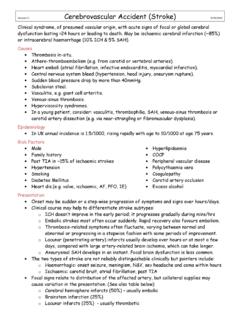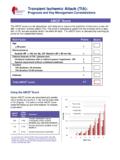Transcription of Ultrasound examination of the femoral and popliteal arteries
1 Beginner corner Medical Ultrasonography2012, Vol. 14, no. 1, 74-77 Ultrasound examination of the femoral and popliteal arteriesSorin Cri an5th Medical Clinic, Iuliu Ha ieganu University of Medicine and Pharmacy Cluj-Napoca, RomaniaReceived Accepted Med Ultrason 2012, Vol. 14, No 1, 74-77 Corresponding author: Sorin Cri an, MD PhD Assoc. Prof. of Internal Medicine 5th Medical Clinic b carilor 11, Zip Code 400139 Phone: + 40722550880 Email: ultrasonography of the femoral - popliteal segment is preceded by clinical examination and ankle-brachial pressure measurement. This important nonin-vasive technique provides detailed information on mor-phology and flow pattern. Doppler Ultrasound allows detection of haemodynamically significant lesions in pa-tients with lower extremity artery disease and selection of the appropriate lesions for endovascular procedures. This method is also useful for the routine follow-up after angioplasty, stent implantation, and bypass graft [1,2].
2 examination techniqueIn order to evaluate the femoral arteries , the patient lies supine, with the leg in slight external rotation. Pop-liteal artery examination is performed with the patient in the supine position with a slight flexion of the knee. If needed, the patient lies prone with the knee in complete extension. In special situations affecting the heart, lungs and articulations, adequate insonation of the femoral - popliteal segment can be performed with the patient sit-ting or standing [3,4].Linear array transducers, with a combination of 7-12 MHz B-mode with a MHz pulse Doppler, provide complete arterial technique has two steps. The first step, including longitudinal and transverse scans, allows iden-tification and characterization of the arteries of interest using B-mode and color flow imaging. Longitudinal scan, starting at the groin and continued distally, is man-datory.
3 The marker of the transducer is located cranial so that the image is oriented with the patient s head to the left of the screen. Beginners may choose to start the examination by cross-sectional view in order to easily identify the anatomic relationships between arteries and surrounding tissues. The second stage of the examination is represented by flow evaluation using pulsed Doppler Ultrasound in longitudinal view with a Doppler angle of 60 degrees or less [3].Normal anatomy The femoral artery is the continuation of the external iliac artery at the level of the inguinal ligament. The ar-tery travels the length of the thigh along a line projected from the mid inguinal ligament to the medial condyle of femur. The femoral artery gives off a branch, the deep femoral artery (DFA), in the proximal part of the femoral triangle. This arterial segment is also called the femoral bifurcation.
4 The segment of the femoral artery located proximally to the arising of the DFA is called the com-mon femoral artery (CFA). The distal part of the femo-ral artery is represented by the superficial femoral artery (SFA) (fig 1-4) [3,5].The CFA lies in front of the hip joint. It has a length of 2-5 cm and a diameter of mm. The femoral vein is located medial to the CFA. The DFA originates from the posterolateral side of the femoral artery then passes to the back of the thigh and ends in the lower third of this segment [3,5]. The SFA runs medial to the body of the femur in the femoral triangle, in the upper third of the thigh, and in the adductor canal, in the middle third of the thigh. The length of the SFA is more than 15-20 cm. The proximal segment has a diameter of mm. The diameter of the distal part of the artery , more profound, is 75 Medical Ultrasonography 2012; 14(1): 74-77 Fig 1.
5 femoral vessels scan at the level of the right groin. a. transverse view. b. longitudinal view. cfa: common femoral artery . cfv: common femoral vein. eia: external iliac 5. Vessels of the popliteal fossa. a. transverse view. b. longitudinal view. pa: popliteal artery . pv: popliteal vein. ma: muscular artery . mv: muscular vein. lsv: lesser (small) saphenous 2. B-mode image of the femoral vessels within the right femoral triangle. a. short-axis view. b. long-axis view. sfa: superficial femoral artery . dfa: deep femoral artery . cfv: common femoral 6. Transverse view showing the spatial relation-ship between the superficial femoral vessels. a. in the upper third of the thigh. b. in the middle third of the thigh. sfa: superficial femoral artery . sfv: superficial femoral vein. gsv: great saphenous 3. Right femoral triangle. Blood vessels are not perfectly aligned in the same parasagittal plane.
6 A. transverse view. b. longitudinal view. sfa: superficial femoral artery dfa: deep femoral artery . cfv: common femoral vein. sfv: superficial femoral vein. dfv: deep femoral 4. Superficial femoral vessels in the middle third of the thigh. Intralumenal parallel echogenic artifacts. a. short-axis view. b. long-axis view. sfa: superficial femoral artery . sfv: superficial femoral Cri anUltrasound examination of the femoral and popliteal arteriesmm. The femoral vein runs medial to the proximal seg-ment of the SFA, behind the middle part, and lateral or posterolateral to the distal third of the artery (fig 6) [3,5]. The SFA passes through the opening in the Adduc-tor magnus and becomes the popliteal artery (PA) at the junction of the middle with the lower third of the thigh. The PA runs behind the femur and anterior to the pop-liteal vein. Because the examination is performed from the popliteal fossa, the popliteal vein is located anterior to the artery (fig 5).
7 The PA divides into anterior and posterior tibial arteries at the level of the lower border of the Popliteus. The length of the PA is more than 6-8 cm. The diameter of the proximal and middle segments is mm. The distal part of the artery has a slightly smaller diameter [3,5].The CFA and PA diameter is significantly correlated with sex, age, height, weight, and body surface area. The diameter is larger in men than in women [6].The wall of the femoral - popliteal segment has a tril-aminar structure representing the intima-media com-plex. The inner and outer parallel layers of the wall are hyperechoic while the middle zone is hypoechoic. The distance between the two hyperechoic layers is called the intima-media thickness (IMT) and it is measured at the far arterial wall in longitudinal plane (fig 1,5,7). The normal value of the IMT increases with age and it is less than mm [3].
8 Normal flow patternThe femoral - popliteal segment has a triphasic flow pattern due to the high peripheral resistance. The first component of the Doppler signal corresponds to the rap-id antegrade flow during systole. The second part of the spectral waveform contour is represented by the reversal flow during early diastole. The little antegrade flow dur-ing mid-diastole produces the third waveform. There is no detectable signal in late diastole (fig 8) [3,4].Peak systolic velocity is high: cm/sec in the CCA, cm/sec in the SCA, and cm/sec in the PA. Peak diastolic reverse velocity and peak diastolic forward velocity are much lower than the systolic velocity [3].The width of the spectral band is narrow especially during systole. There is a slightly increased spectral bandwidth at the level of the femoral bifurcation due to normal flow disturbances [3].AdvantagesThe most important advantages of the method are the rare arterial variants (location of the DFA origin, duplica-tion of the SFA, high bifurcation of the PA), good interob-server reproducibility, adequate detection of some changes in vessel morphology like increased IMT and plaque as in-dicators of subclinical atherosclerosis, and accurate infor-mation on lesion type, location, extent and severity [1,3,7].
9 Compared with angiography, Doppler Ultrasound de-tects the haemodynamically significant stenosis (diam-eter reduction of more than 50%) with a sensitivity of 85-90% and a specificity of more than 95% [1].Limitations and sources of errorThere are several limitations of the method: deep location of the distal SFA in patients with obesity and oedema, low detection of the lumen in the presence of Fig 8. Longitudinal view of the right superficial fem-oral and popliteal arteries . Typical Doppler spectrum. a. superficial femoral artery . b. popliteal artery . sfa: superficial femoral artery . pa: popliteal artery . pv: popliteal 7. Longitudinal view of the right common and su-perficial femoral arteries . Normal intima-media thick-ness. a. common femoral artery . b. superficial femoral artery . cfa: common femoral artery . sfa: superficial femoral artery . sfv: superficial femoral Ultrasonography 2012; 14(1): 74-77near wall calcifications, involuntary leg movements, and hyperaesthesia.
10 B-mode and color imaging can not deter-mine the correct degree of arterial narrowing without the help of the pulsed sources of error are the insufficient exam-iner s experience and time, inappropriate use of some pa-rameters (velocity scale, Doppler angle, placement and size of the sample volume, wall filter, gray-scale, color and Doppler gain), and Ultrasound artifacts (intralume-nal parallel echogenic lines as shown in fig 4, marginal shadow phenomenon, and aliasing)References 1. Tendera M, Aboyans V, Bartelink ML et al. ESC Guidelines on the diagnosis and treatment of peripheral artery diseases. Document covering atherosclerotic disease of extracranial carotid and vertebral, mesenteric, renal, upper and lower extremity arteries . The Task Force on the Diagnosis and Treatment of Peripheral artery Diseases of the European Society of Cardiology (ESC). Eur Heart J 2011; 32: 2851-2906.







